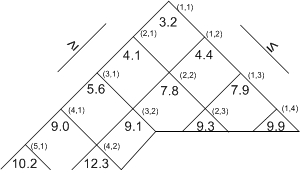
Beap
Encyclopedia
Beap, or bi-parental heap
, is a data structure
where a node usually has two parents (unless it is the first or last on a level) and two children (unless it is on the last level). Unlike a heap, a beap allows sublinear search. The beap was introduced by Ian Munro and Hendra Suwanda. A related data structure is the Young tableau
.

 . Also, assuming the last level is full, the number of elements on that level is also
. Also, assuming the last level is full, the number of elements on that level is also  . In fact, because of these properties all basic operations (insert, remove, find) run in
. In fact, because of these properties all basic operations (insert, remove, find) run in  time on average. Find operations in the heap can be
time on average. Find operations in the heap can be  in the worst case. Removal and insertion of new elements involves propagation of elements up or down (much like in a heap) in order to restore the beap invariant. An additional perk is that beap provides constant time access to the smallest element and
in the worst case. Removal and insertion of new elements involves propagation of elements up or down (much like in a heap) in order to restore the beap invariant. An additional perk is that beap provides constant time access to the smallest element and  time for the maximum element.
time for the maximum element.
Actually, a find operation can be implemented if parent pointers at each node are maintained. You would start at the absolute bottom-most element of the top node (similar to the left-most child in a heap) and move either up or right to find the element of interest.
find operation can be implemented if parent pointers at each node are maintained. You would start at the absolute bottom-most element of the top node (similar to the left-most child in a heap) and move either up or right to find the element of interest.
Heap (data structure)
In computer science, a heap is a specialized tree-based data structure that satisfies the heap property: if B is a child node of A, then key ≥ key. This implies that an element with the greatest key is always in the root node, and so such a heap is sometimes called a max-heap...
, is a data structure
Data structure
In computer science, a data structure is a particular way of storing and organizing data in a computer so that it can be used efficiently.Different kinds of data structures are suited to different kinds of applications, and some are highly specialized to specific tasks...
where a node usually has two parents (unless it is the first or last on a level) and two children (unless it is on the last level). Unlike a heap, a beap allows sublinear search. The beap was introduced by Ian Munro and Hendra Suwanda. A related data structure is the Young tableau
Young tableau
In mathematics, a Young tableau is a combinatorial object useful in representation theory. It provides a convenient way to describe the group representations of the symmetric and general linear groups and to study their properties. Young tableaux were introduced by Alfred Young, a mathematician at...
.

Performance
The height of the structure is approximately . Also, assuming the last level is full, the number of elements on that level is also
. Also, assuming the last level is full, the number of elements on that level is also  . In fact, because of these properties all basic operations (insert, remove, find) run in
. In fact, because of these properties all basic operations (insert, remove, find) run in  time on average. Find operations in the heap can be
time on average. Find operations in the heap can be  in the worst case. Removal and insertion of new elements involves propagation of elements up or down (much like in a heap) in order to restore the beap invariant. An additional perk is that beap provides constant time access to the smallest element and
in the worst case. Removal and insertion of new elements involves propagation of elements up or down (much like in a heap) in order to restore the beap invariant. An additional perk is that beap provides constant time access to the smallest element and  time for the maximum element.
time for the maximum element.Actually, a
 find operation can be implemented if parent pointers at each node are maintained. You would start at the absolute bottom-most element of the top node (similar to the left-most child in a heap) and move either up or right to find the element of interest.
find operation can be implemented if parent pointers at each node are maintained. You would start at the absolute bottom-most element of the top node (similar to the left-most child in a heap) and move either up or right to find the element of interest.

